10 MIN READ
How to Distinguish the Difference Between Phytophthora and Stem Canker in Soybean
September 15, 2021
Phytophthora root and stem rot, Northern stem canker, and Southern stem canker are soybean diseases that can reduce yield potential and can be found throughout the soybean growing areas of the United States. Symptom similarities among them can lead to confusion and misidentification. This spotlight concentrates on the identification and symptom differentiation between the diseases.
Phytophthora Root and Stem Rot (PRR) are caused by the fungal-like water molds Phytophthora sojae and Phytophthora sansomeana with P. sojae being the most common.
Northern stem canker (NSC) caused by Diaporthe caulivora and Southern stem canker (SSC) caused by Diaporthe aspalath are two of the four diseases that comprise the Diaporthe-Phomopsis disease complex. The complex also consists of seed decay, caused primarily by Diaporthe longicolla (old name Phomopsis longicolla) and pod and stem blight (PSB) caused by Diaporthe sojae.
What are the optimum times for infection?
PRR: Optimum infection occurs at emergence (VE) when soil may have more water content. However, infection can occur throughout the growing season when soils are damp to wet. Wet soils support the growth of fungal-like water molds that cause infection. Infection takes place below ground and through the root system causing soft rot of root tissues.
Canker Diseases: Early vegetative soybean growth stages (V1 to V7) are optimum for infection with V3 growth stage being the most critical.1 Infection occurs above ground through nodes and does not affect root health.
Is there a soil type association for each disease?
PRR: Clay, compacted, and poorly drained soils.
Canker Diseases: Soils with high organic matter, fields with soybean residue, and high fertility fields.2
What growing conditions favor disease development?
PRR: Wet (saturated) and warm soil conditions. Infection can occur when soil temperatures are above 50° F; however, severe infection is favored by soil temperatures above 60° F.3
Canker Diseases:
- Extended periods (24 to 96 hours) of moderate temperatures (72 to 96° F), wet weather during early crop development (about V3 growth stage), and high humidity (80% or higher).1
- Hail damaged fields may exhibit increased stem canker development.4
When are symptoms visible?
PRR: Symptoms usually occur after extended periods of rainfall when soil temperatures exceed 60° F.
Canker Diseases: Usually during plant reproductive growth stages as symptoms can remain hidden after early growth stage infection. Infected seedlings can die quickly.
What are the symptoms for each disease?
PRR:
- Seedling
- Infection occurs through roots and moves up the stem.
- Roots become brown and rotted causing death from damping-off (Figure 1).5
- Laboratory analysis is required to distinguish PRR from Pythium.

- Older Plants
- Leaves become yellow, wilt, and usually remain attached to the plant.
- Stunting (Figure 2).
- Chocolate-brown stem lesion extends upward from below the soil line to lower stem nodes (Figure 3)
- Brown lesions develop on roots and inner tissues develop a tan to brown discoloration.
- Dead plants are usually found in patches or sections within a row.
- Tolerant soybean products may only exhibit root rot.
- Lesions caused by NSC and SSC resemble PRR lesions; however, the canker lesions generally start at a node and spread up and down the stem.

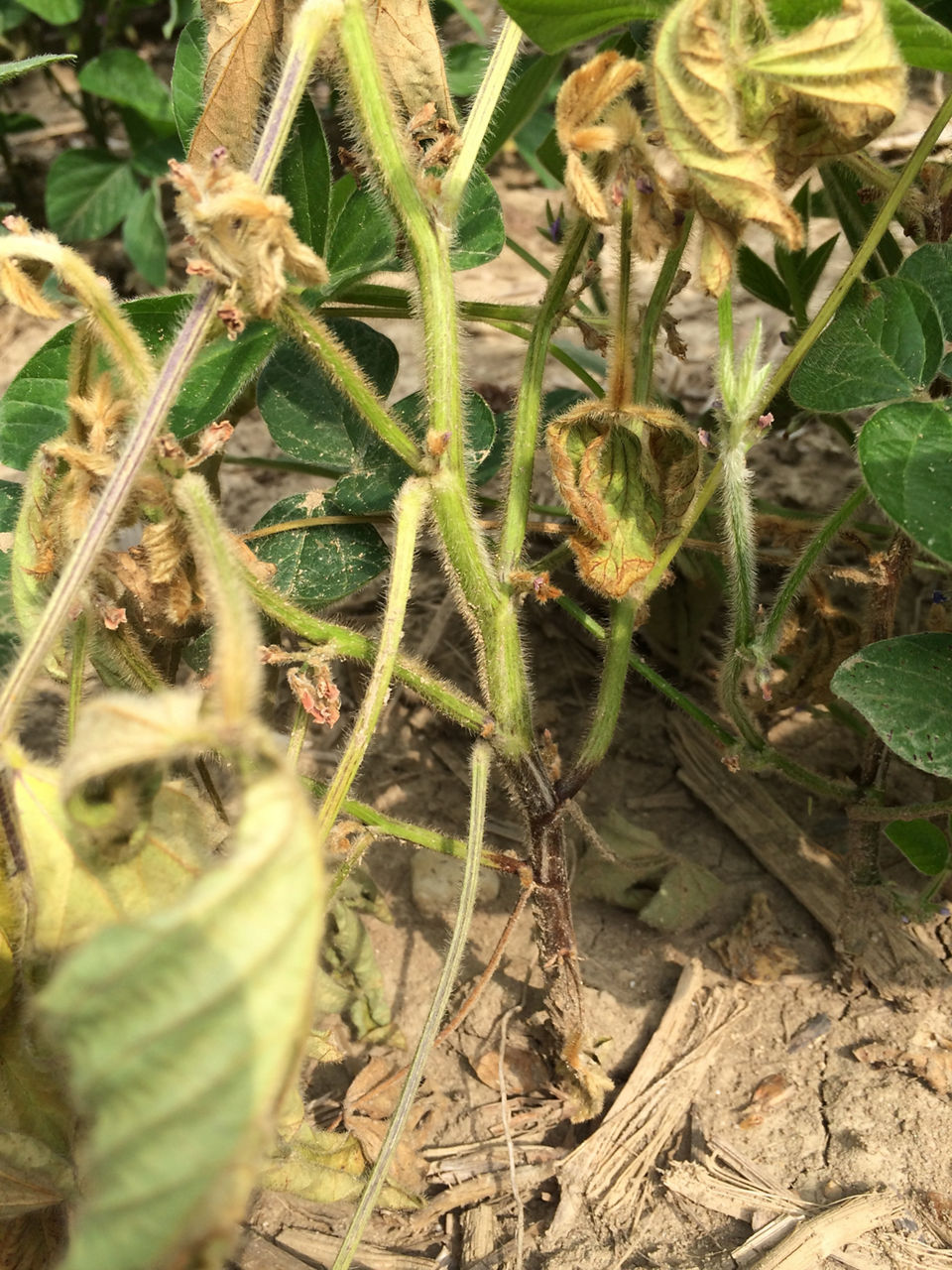
Canker Diseases:
Reddish-brown to dark brown stem lesions (cankers) develop near stem nodes during early reproductive growth stages (Figures 4 and 6). Infections that occur at lower nodes can give the appearance of originating below ground.
Southern stem canker lesions generally have a darker margin.
Green stem tissue is usually present above and below the cankers (Figures 4, 5, and 6).
Disease progression results in the cankers enlarging in length, turning dark brown to black, becoming slightly sunken, and eventually girdle the stems (Figures 5 and 7).
Plants may exhibit nutrient deficiencies because of the girdling.
In contrast to PRR, canker disease lesions may occur higher on the stems.4
The canker diseases do not affect roots while PRR does.
Plants can suffer sudden, premature plant death.
Usually, scattered plants or small patches may show symptoms; whole field infection is rare.
Initially, leaves may exhibit interveinal yellowing (more common with SSC) followed by tissue death between the veins (Figure 8).
Infected leaves usually remain attached to the plant.
Plants can snap easily at canker locations.
Plants can have healthy and infected stem branches if girdling does not occur on main stem.
Stem interior may develop brown discoloration.2
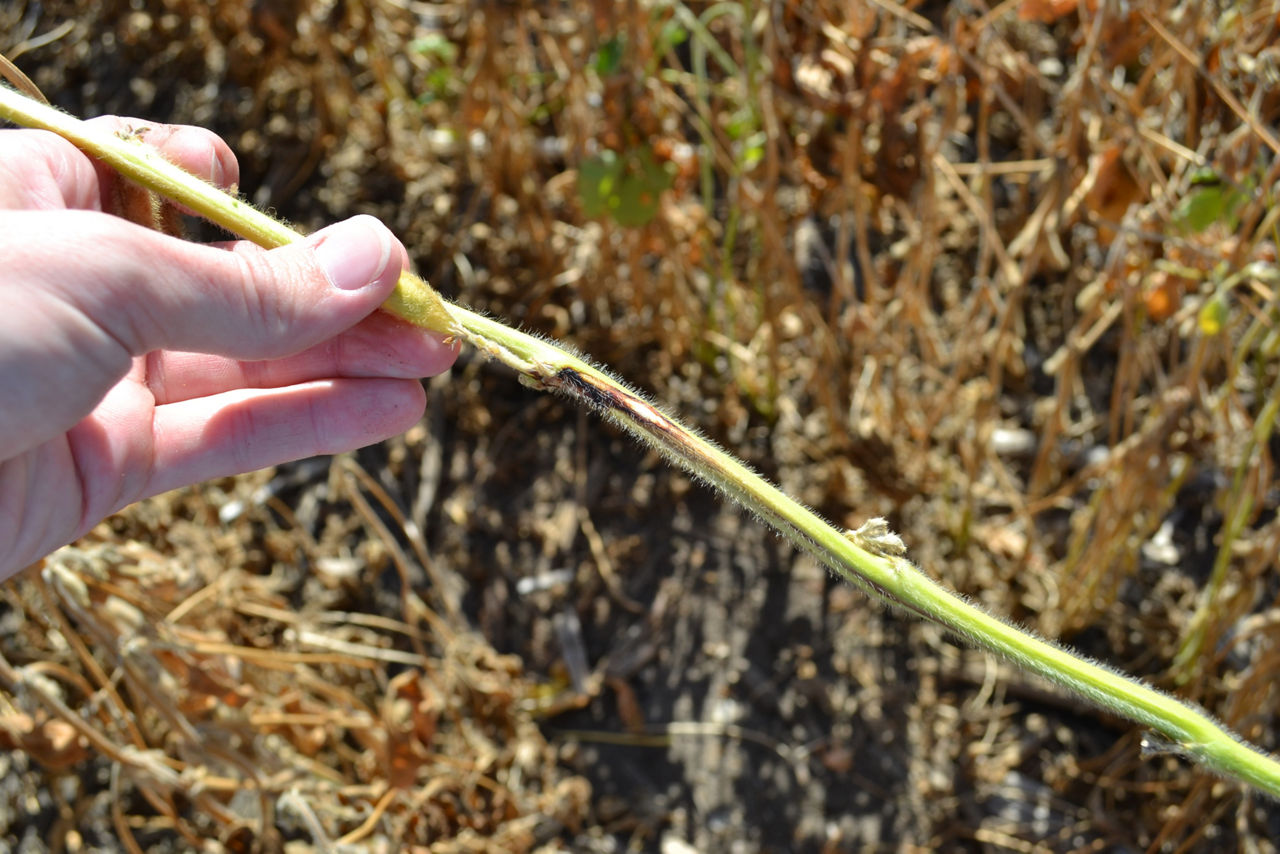
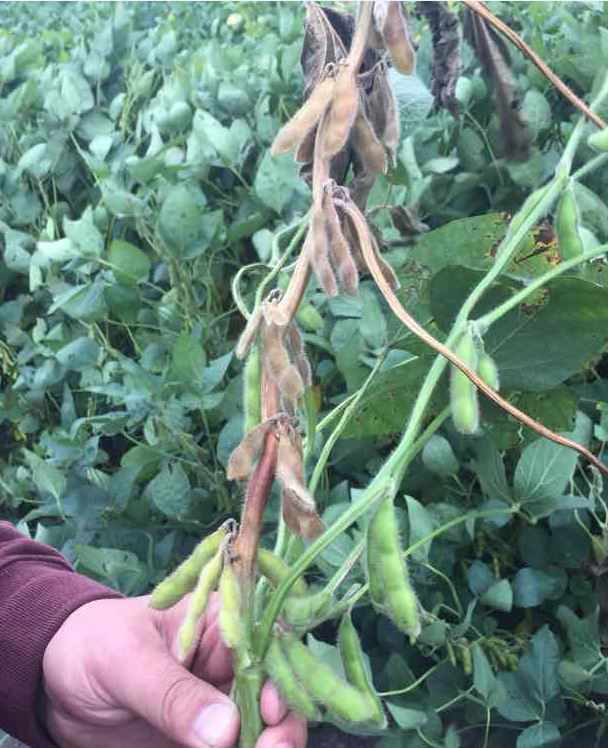


Can these diseases be confused with other soybean diseases?
PRR: Depending on disease severity and time of observation, canker lesions can mimic PRR lesions. Phytophthora lesions develop below ground and extend up the stem while canker lesions develop above the soil line and usually have green tissue above and below the lesions (Figures 4 and 6). Additionally, PRR affects the roots while the canker diseases do not.
Canker Diseases:
Interveinal leaf chlorosis of the stem canker diseases mimics the foliar chlorosis of brown stem rot and sudden death syndrome (Figure 8). The chlorosis is more common to SSC than NSC.
Interior stem browning can resemble that of brown stem rot.
Stem lesions can resemble PRR stem lesions; however, in contrast to PRR, the canker diseases have green tissue above and below the lesions.
Canker lesions near the soil line can resemble those of PRR; however, the canker diseases do not have root rot and their lesions extend downward from a node while PRR lesions extend upward from the soil line.
From a distance, field yellowing can resemble white mold, PRR, sudden death syndrome, and brown stem rot.

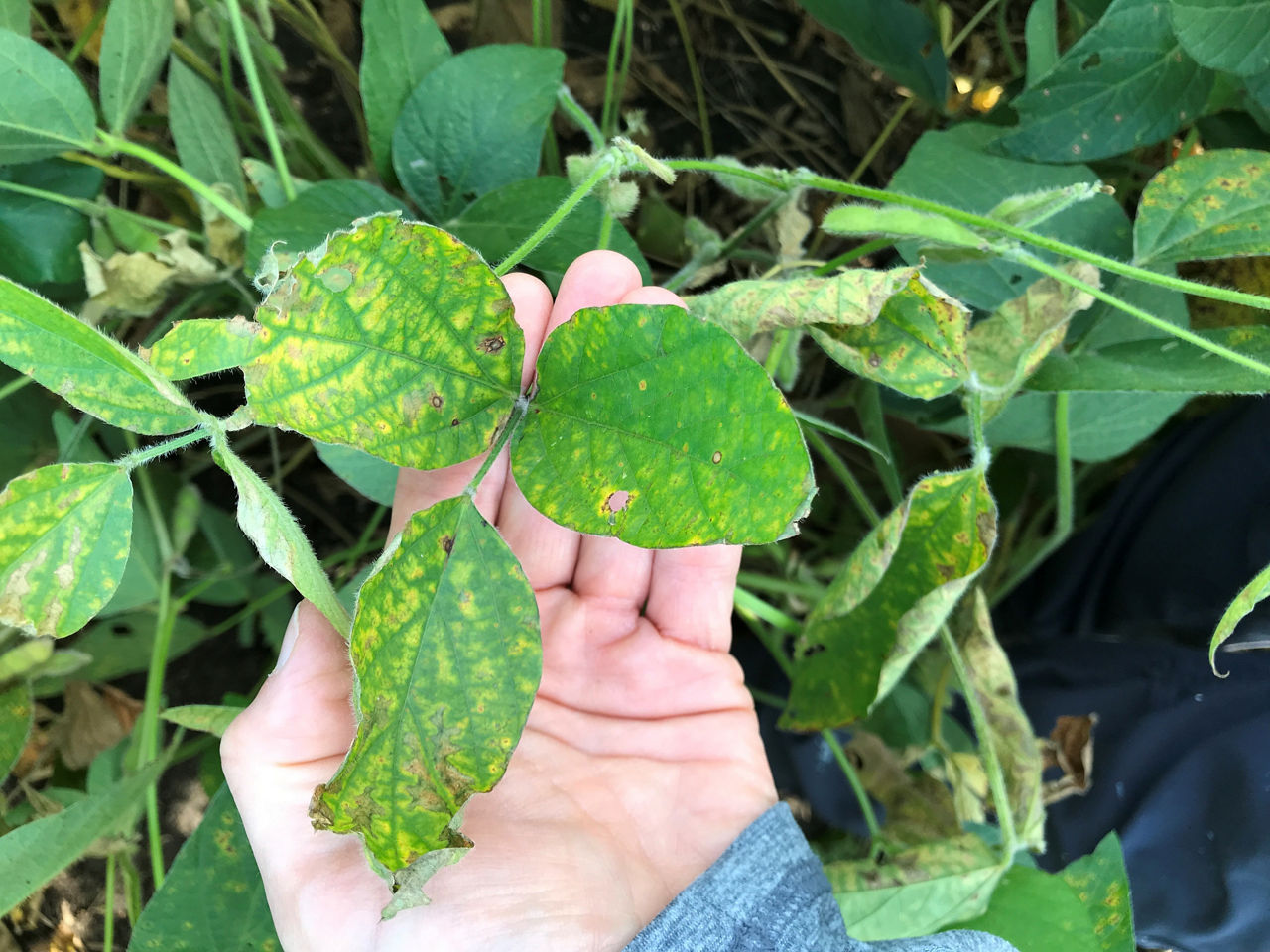
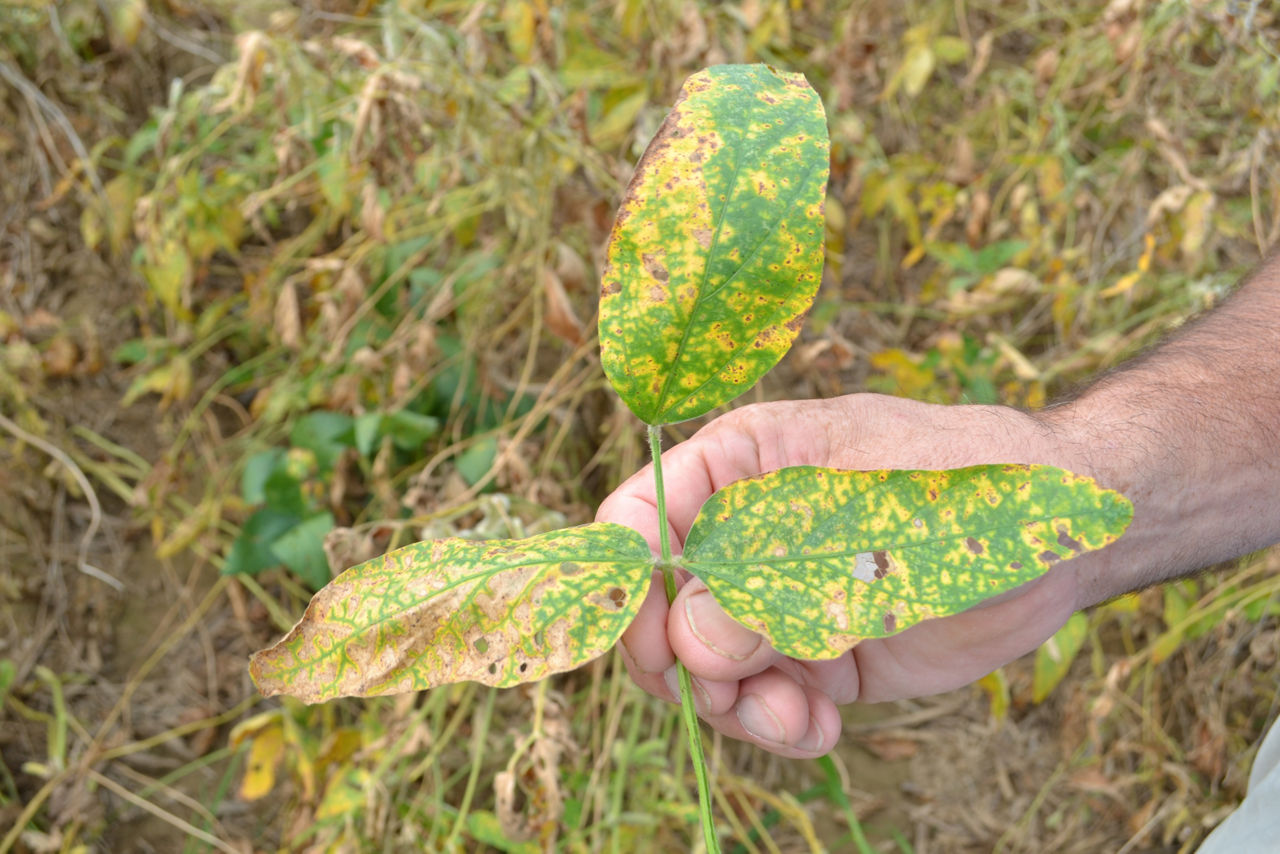
Figure 8. Disease identification by leaf lesions can be difficult because of similarities. Brown stem rot (a), Southern stem canker (b), and sudden death syndrome (c) develop interveinal chlorosis patterns that are very similar. Brown stem rot leaf picture courtesy of and used with the permission of Dean Malvick, University of Minnesota.
What is the management strategy for each disease?
PRR:
Soybean product selection that includes Rps gene(s) and good field tolerance in conjunction with a seed treatment with specific efficacy for PRR.
Planting of soybean products with specific Rps resistance genes relative to those identified within a field.
Numerous Phytophthora sojae pathotypes exist with many of them occurring in the same field; therefore, pathotype identification is necessary to help select soybean products with the specific race resistance required for each field.
Plant soybean products with partial resistance or “root rot resistance”, which have different levels of resistance to the different races. Soybean products with good partial resistance may still develop symptoms but yield impact is greatly reduced (Figure 9).
Resistance genes available include Rps1a, Rps1c, Rps1k, Rps3a, and Rps 1k+ 3a.
Improve soil drainage and manage compaction.
Utilize seed treatments that can help manage seedling PRR.

Canker Diseases:
Plant resistant soybean products.
Rotate crops and incorporate residue to help reduce inoculum.
Fungicide applications during reproductive growth stages may help reduce severity.
Sources:
1Hershman, D. E. 2013. Stem canker of soybean. Plant Pathology Fact Sheet. PPFS-AG-S-07. University of Kentucky. http://plantpathology.ca.uky.edu/files/ppfs-ag-s-07.pdf.
2Jardine, D.J. 2020. Stem Canker. Soybean Diseases. Soybean Research & Information Network. https://soybeanresearchinfo.com/soybean-disease/stem-canker/.
3Martin, D. and Dorrance, A.E. 2019. Phytophthora damping-off and root rot of soybean. PLPATH-SOY-04. Ohioline. The Ohio State University. https://ohioline.osu.edu/factsheet/plpath-soy-04.
4Giesler, L.J. Stem canker. Soybean Diseases. CROPWATCH. University of Nebraska-Lincoln. https://cropwatch.unl.edu/plantdisease/soybean/stem-canker.
5Malvick, D. 2018. Phytophthora root and stem rot on soybean. Soybean Pest Management. University of Minnesota Extension. https://extension.umn.edu/pest-management/phytophthora-root-and-stem-rot-soybean.
Web sites verified 7/2/21. 6003_Q3